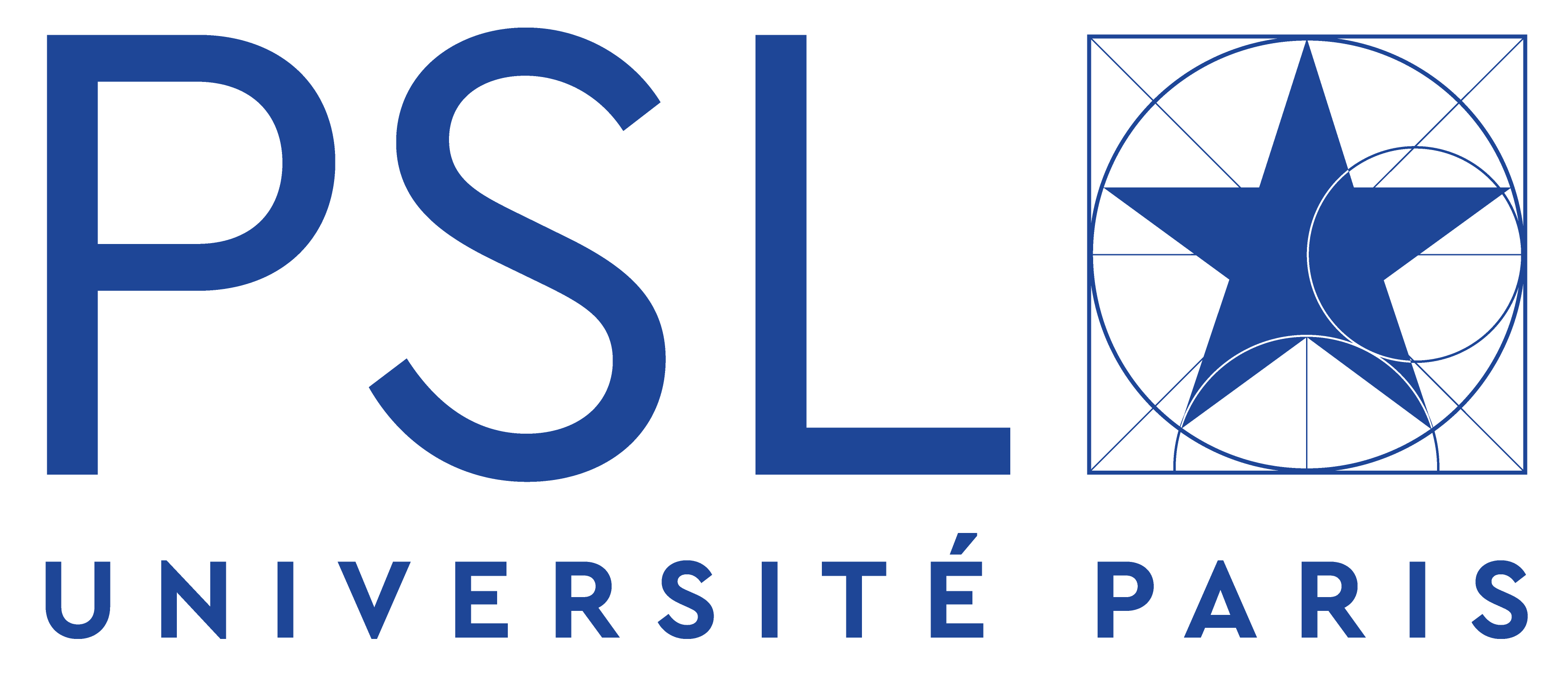Impulsive shock wave propagation in granular packings under gravity
Van Den Wildenberg, S., X. Nguyen, A. Tourin, and X. Jia
Mechanics Research Communications 150 (2025)

Résumé: We experimentally investigate the impulsive shock propagation caused by an impact into vertically oriented 3D granular packings under gravity. We observe a crossover of wave propagation, from sound excitation at low impact to shock front formation at high impact. One of our findings is a nonlinear acoustic regime prior to the shock regime in which the wave speed decreases with the particle-velocity amplitude due to frictional sliding and rearrangement. Also, we show that the impulsive shock waves at high impact exhibit a characteristic spatial width of approximately 10 particle diameters, regardless of shock amplitude. This finding is similar to that observed in 1D granular chains and appears to be independent of the contact microstructure, whether involving dry or weakly wet glass beads, or sand particles. The final and main finding is that we observe the coexistence of the shock front and the sound waves (ballistic propagation and multiple scattering), separated by a distinct time interval. This delay increases with impact amplitude, due to the increase shock speed on one hand and the decrease of the elastic modulus (and sound speed) in mechanically weakened granular packings by high impact on the other hand. Introducing a small amount of wetting oil into glass bead packings leads to significant viscous dissipation of scattered acoustic waves, while only slightly affecting the shock waves evidenced by a modest increase in shock front width. Our study reveals that shock-induced sound waves and scattering play an important role in shock wave attenuation within a mechanically weakened granular packing by impact. Investigating impact-driven wave propagation through such a medium also offers one way of interrogating a 3D FPUT-like system where nonlinear and linear forces between grains are involved.
|

|
Detection and characterization of targets in complex media using fingerprint matrices
Le Ber, A., A. Goïcoechea, L. M. Rachbauer, W. Lambert, X. Jia, M. Fink, A. Tourin, S. Rotter, and A. Aubry
Nature Physics 21, no. 10, 1609-1615 (2025)

Résumé: When waves propagate through a complex medium, they undergo several scattering events. This phenomenon is detrimental to imaging, as it causes full blurring of the image. Here we describe a method for detecting, localizing and characterizing any scattering target embedded in a complex medium. We introduce a fingerprint operator that contains the specific signature of the target with respect to its environment. When applied to the recorded reflection matrix, it provides a likelihood index of the target state. This state can be the position of the target for localization purposes, its shape for characterization or any other parameter that influences its response. We demonstrate the versatility of our method by performing proof-of-concept ultrasound experiments on elastic spheres buried inside a strongly scattering granular suspension and on lesion markers, which are commonly used to monitor breast tumours, embedded in a foam mimicking soft tissue. Furthermore, we show how the fingerprint operator can be leveraged to characterize the complex medium itself by mapping the fibre architecture within muscle tissue. Our method is broadly applicable to different types of waves beyond ultrasound for which multi-element technology allows a reflection matrix to be measured.
|


|
Influence of Normal Stress, Shear Velocity and Materials on Steady-State Shear Resistance and Viscosity of Rapid Dry Granular Flows
Hu, W., Y. Li, H. Gou, X. Jia, L. Zhou, and C. Chang
Journal of Geophysical Research Solid Earth 130, no. 6 (2025)

Résumé: Understanding the rheological behavior of rapid granular flows is crucial for understanding various geological processes, such as fast fault slip and rapid motion of landslides. In this study, we conducted rotary shear experiments on different granular materials, spanning a range of shear velocities from slow to rapid and under varying normal stresses, to investigate the evolution of mechanical behavior under different flow conditions. The experimental results showed that steady-state shear resistance varied with normal stress and material composition at shear velocities below 1 m/s. A consistent velocity-dependent trend was observed. The steady-state shear resistance of the sample experienced a transition from velocity-strengthening behavior at low shear velocities (below 0.1 m/s) to velocity-weakening behavior at higher shear velocities (above 0.1 m/s). Interestingly, at shear velocities exceeding 1 m/s, the steady-state shear resistance became independent of normal stress and material composition, converging to a similar steady-state value for both crushable and uncrushable materials. Although normal stress and mineral composition had a limited influence on steady-state shear resistance at high shear rates, they significantly affected the weakening rate (the transition from peak strength to steady-state shear resistance), which was strongly correlated with the material's crushing ability, as characterized by the Weibull modulus. These findings provide insights into the mechanisms governing the hypermobility of mega-landslides and the rapid dynamics of geological flows.
|

|
Ultrasound-induced dense granular flows: a two-time scale modelling
Martin, H. A., A. Mangeney, X. Jia, B. Maury, A. Lefebvre-Lepot, Y. Maday, and P. Dérand
Journal of Fluid Mechanics 1004 (2025)

Résumé: Understanding the mechanisms behind the remote triggering of landslides by seismic waves at micro-strain amplitude is essential for quantifying seismic hazards. Granular materials provide a relevant model system to investigate landslides within the unjamming transition framework, from solid to liquid states. Furthermore, recent laboratory experiments have revealed that ultrasound-induced granular avalanches can be related to a reduction in the interparticle friction through shear acoustic lubrication of the contacts. However, investigating slip at the scale of grain contacts within an optically opaque granular medium remains a challenging issue. Here, we propose an original coupling model and numerically investigate two-dimensional dense granular flows triggered by basal acoustic waves. We model the triggering dynamics at two separated time scales - one for grain motion (milliseconds) and the other for ultrasound (10μs) - relying on the computation of vibrational modes with a discrete element method through the reduction of the local friction. We show that ultrasound predominantly propagates through the strong-force chains, while the ultrasound-induced decrease of interparticle friction occurs in the weak contact forces perpendicular to the strong-force chains. This interparticle friction reduction initiates local rearrangements at the grain scale that eventually lead to a continuous flow through a percolation process at the macroscopic scale - with a delay depending on the proximity to the failure. Consistent with experiments, we show that ultrasound-induced flow appears more uniform in space than pure gravity-driven flow, indicating the role of an effective temperature by ultrasonic vibration.
|

|
Metastable state preceding shear zone instability: Implications for earthquake-accelerated landslides and dynamic triggering
Li, Y., W. Hu, Q. Xu, H. Luo, C. Chang, and X. Jia
Proceedings of the National Academy of Sciences 122, no. 1 (2025)
|


|
Variation in Granular Frictional Resistance Across Nine Orders of Magnitude in Shear Velocity
Gou, H. X., W. Hu, Q. Xu, J. Chen, M. J. Mcsaveney, E. C. P. Breard, R. Q. Huang, Y. J. Wang, X. P. Jia, and L. Zhou
Journal of Geophysical Research: Solid Earth 129, no. 7 (2024)

Résumé: Determining the shear-velocity dependence of dry granular friction can provide insight into the controlling variables in a dry granular friction law. Some laboratories believe that the quality of this study is at the forefront of the discipline for the following reasons. Results suggest that granular friction is greatly affected by shear-velocity (v), but shear experiments over the large range of naturally occurring shear-velocities are lacking. Herein we examined the shear velocity dependence of dry friction for three granular materials, quartz sand, glass beads and fluorspar, across nine orders of magnitude of shear velocity (10−8–2 m/s). Within this range, granular friction exhibited four regimes, following a broad approximate “m” shape including two velocity-strengthening and two velocity-weakening regimes. We discuss the possible physical mechanisms of each regime. This shear velocity dependence appeared to be universal for all particle types, shapes, sizes, and for all normal stresses over the tested range. We also found that ultra-high frequency vibration as grain surfaces were scoured by micro-chips were formed by spalling at high shear velocities, creating ∼20 μm diameter impact pits on particle surfaces. This study provides laboratory laws of a friction-velocity (μ-v) model for granular materials.
|


|
Acoustic monitoring of compaction in cohesive granular materials
Canel, V., X. Jia, M. Campillo, and I. Ionescu
Physical Review E 109, no. 2 (2024)
|


|
High time-resolved studies of stick–slip show similar dilatancy to fast and slow earthquakes
Hu, W., Y. Ge, Q. Xu, R. Huang, Q. Zhao, H. Gou, M. Mcsaveney, C. Chang, Y. Li, X. Jia, and Y. Wang
Proceedings of the National Academy of Sciences 120, no. 47 (2023)
|


|
Repetitive small seismicity coupled with rainfall can trigger large slope instabilities on metastable volcanic edifices
Durand, V., A. Mangeney, P. Bernard, X. Jia, F. Bonilla, C. Satriano, J. M. Saurel, E. M. Aissaoui, A. Peltier, V. Ferrazzini, P. Kowalski, F. Lauret, C. Brunet, and C. Hibert
Communications Earth and Environment 4, no. 1 (2023)

Résumé: Quantifying the effect of external forcings like seismicity or rain on slope destabilization is a long-standing and challenging issue. To investigate the respective roles of these forcings, we analyze an unprecedented 10-year long catalog of rockfalls occurring in the crater of the Piton de la Fournaise volcano (La Reunion Island), using statistical tools originally developed for earthquakes. Our analysis reveals the predominant effect of low amplitude repetitive seismicity in the triggering of rockfalls located at a few kilometers from the source, due to progressive damaging of the slope. Moreover, we show that the efficiency and time-delay of this dynamic triggering is controlled by the stability state of the slope, i.e. its closeness to the failure, as observed with lab-experiments on metastable granular slopes. Our results show the need to account for long-term swarm-type seismic activity that can affect the stability of geological structures like slopes and faults, but also buildings.
|


|
Stick-Slip Nucleation and Failure in Uniform Glass Beads Detected by Acoustic Emissions in Ring-Shear Experiments: Implications for Identifying the Acoustic Emissions of Earthquake Foreshocks
Gou, H. X., W. Hu, Q. Xu, R. Q. Huang, M. J. Mcsaveney, X. Jia, and Y. J. Wang
Journal of Geophysical Research: Solid Earth 128, no. 8 (2023)

Résumé: Stress accumulation and release reflected by acoustic emissions (AEs) during shearing of granular materials provide important information on failure mechanisms in seismic faults and landslides controlled by stick-slip. Among many characteristics (amplitude, energy, counts, and frequency) of AE signals generated by stick-slip, stress changes corresponding to various frequency AEs in different stages of the stick-slip process are not clear, which limits our knowledge of the characteristics of precursory signals before stick-slip failure. To better understand the physical mechanisms of granular stick-slip, we monitored the mechanical and AE signals using high-frequency (2 MHz) synchronous acquisition during constant-speed shear of packs of uniform glass beads with different sizes at different normal stresses. The release rate of AE energy was found to accelerate with the dilatation of the sample volume, and the stress drop of stick-slip was augmented with the increase of normal stress and particle size. Three characteristic events of single cycle stick-slip were observed in this study: main slip, minor slip, and microslip. We analyzed the AE frequency spectra of these three event types. Both main slip and minor slip corresponded to stress drop and generated high-frequency AEs (about several hundred kHz), while the AE frequencies generated by microslip were lower (about tens of kHz) and exhibited stress strengthening, which were not apparent in previous studies due to the low frequency of acquisition. We propose that the microslip is mainly due to sliding on grain contacts, while the main slip and minor slip resulted from breakage and reforming of force chains. Low-frequency AEs from microslip may suggest a crucial precursor of seismic faults and landslides.
|

|
Damage in cohesive granular materials: simulations and geophysical implications
Canel, V., M. Campillo, X. Jia, and I. R. Ionescu
Comptes Rendus - Geoscience 355, no. S3, 1-21 (2023)
Résumé: The aim of this paper is to test a simple damage model of a cohesive granular medium to study the relationship between the damage and velocity of elastic waves. Our numerical experiments of edometric compression show that the microscopic deformation quickly becomes very heterogeneous, while our simulations of elastic waves propagation show that a small amount of damage induces a dramatic decrease in the elastic velocity. This shows that cohesive discrete media are very sensitive to strain field heterogeneity, and that the wave velocities in these media can measure subtle transient deformation processes, such as earthquake initiation phases.
|

|
Damping-Driven Time Reversal for Waves
Hidalgo-Caballero, S., S. Kottigegollahalli Sreenivas, V. Bacot, S. Wildeman, M. Harazi, X. Jia, A. Tourin, M. Fink, A. Cassinelli, M. Labousse, and E. Fort
Physical Review Letters 130, no. 8 (2023)
Résumé: Damping is usually associated with irreversibility. Here, we present a counterintuitive concept to achieve time reversal of waves propagating in a lossless medium using a transitory dissipation pulse. Applying a sudden and strong damping in a limited time generates a time-reversed wave. In the limit of a high damping shock, this amounts to "freezing"the initial wave by maintaining the wave amplitude while canceling its time derivative. The initial wave then splits in two counterpropagating waves with half of its amplitude and time evolutions in opposite directions. We implement this damping-based time reversal using phonon waves propagating in a lattice of interacting magnets placed on an air cushion. We show with computer simulations that this concept also applies to broadband time reversal in complex disordered systems.
|

|
Acoustic Localization of an Intruder in a Strongly Scattering Medium
Van Den Wildenberg, S., X. Jia, J. L. Gennisson, and A. Tourin
Physical Review Applied 18, no. 6 (2022)

Résumé: Localizing an intruder submerged in a strongly scattering medium, such as a dense granular suspension, is a practical challenge. Here we extract the coherent ultrasonic echo from a steel ball submerged in a dense glass-bead packing saturated by water, by using a standard single-element ultrasonic transducer thanks to a configuration averaging process. Different configurations of the granular packing are created by the nonaffine motion of the beads with a mixing blade, akin to the Brownian motion, in the vicinity of the intruder. We investigate the efficiency of this process to reduce the so-called material noise from multiply scattered ultrasound, as a function of the configuration number, the shear rate and the blade-intruder distance. Nonaffine motions of the beads in the shear zone induced by the blade are then analyzed on the basis of a split-bottom rotating shear cell. This method helps to develop not only ultrasonic imaging tools of buried objects in turbid marine sediments, but also the local rheology based on a ball falling monitored by ultrasonic tracking.
|

|
Effect of Amplitude and Duration of Cyclic Loading on Frictional Sliding Instability in Granular Media: Implication to Earthquake Triggering of Landslides
Hu, W., H. Luo, Q. Xu, M. Mcsaveney, R. Huang, J. Zheng, Y. Wang, and X. Jia
Journal of Geophysical Research: Solid Earth 127, no. 11 (2022)

Résumé: Strong earthquakes with larger magnitude and longer durations trigger many landslides, however, how magnitude and duration affect landslides is still unclear. Many factors could contribute to this, including additional shear stress provided by strong ground motion, or “seismogenic liquefaction”; herein, we hypothesize that the dynamic weakening of sliding zone gouge is important. We explored the influence of earthquake magnitude and duration on landslide triggering by simulating the seismic response of sliding zone gouge using a dynamic ring-shear device and glass spheres. The experiments showed that vibration with larger amplitudes and longer durations more easily trigger deformation and even instability in dry granular materials. We used a dynamic triaxial-bender system to find that the shear modulus of these materials decreased with the increase in duration and amplitude of cyclic loading. We suggest that this universal decrease in shear modulus is an important landslide-trigger mechanism. Our results revealed how magnitude and duration of earthquakes affect co-seismic landslides and why earthquakes with larger magnitude and long durations can trigger more co-seismic landslides.
|

|
Monte Carlo Simulations of Ultrasound Scattering and Absorption in Finite-Size Heterogeneous Materials
Zhou, H., X. Jia, L. Y. Fu, and A. Tourin
Physical Review Applied 16, no. 3 (2021)

Résumé: Determination of ultrasound scattering and intrinsic attenuations in heterogeneous media is of importance from material characterization to geophysical applications. Here, we present an efficient inverse method within a finite-size scattering medium, where boundary reflection plays a crucial role. To fit the energy profile of scattered coda waves, we solve the acoustic radiative-transfer equation by Monte Carlo simulations for cylinder and slab geometries, under the isotropic scattering approximation. We show that the fit with the simplistic radiative-transfer solution in an infinite medium may result in underestimated values of the scattering mean free path, ls, and absorption, Qi-1, by up to 40%. Our main finding is anomalous transport behavior in thin slab samples, where the ballistic peak and the diffusionlike one are merged into one single peak. This anomalous behavior, related to a wave-focusing effect in the forward direction, can mislead the inverse process and lead to an overestimation of ls by more than 200%. We compare simulated energy profiles with ultrasound envelopes obtained in a polycrystal-like granite slab from the ballistic to the diffusive regime. The ls deduced from off-axis detections agrees with that estimated from the correlation length of the shear-wave velocity by structural imaging analysis.
|

|
Probing intermittency and reversibility in a dense granular suspension under shear using multiply scattered ultrasound
Léopoldès, J., and X. Jia
Soft Matter 16, no. 47, 10716-10722 (2020)
Résumé: © 2020 The Royal Society of Chemistry. We study the rheology of a dense granular suspension under shear strain with the simultaneous detection of multiply scattered ultrasound through the shear band. At a low shear rate, the dissipation is rate-independent and determined by the frictional contacts between grains. Under quasistatic shear, the stress-strain curve contains elastic loading parts interrupted by stress drops. Such an intermittency is concomitant with some large decorrelation events as measured by the ultrasound probe, sensitive to the position of the grains. Under cyclic shear, the correlations between the scattered ultrasonic waves show that at low shear strain, the grains exhibit reversible motion. Beyond this linear regime, some irreversible motion of the grains is detected. Moreover, the correlation between successive ultrasound signals suggests that some specific rearrangements, which add to the homogeneous flow, take place near the maximum strain.
|

|
Triggering granular avalanches with ultrasound
Léopoldès, J., X. Jia, A. Tourin, and A. Mangeney
Physical Review E 102, no. 4 (2020)

Résumé: © 2020 American Physical Society. Granular flows triggered by vibration below the avalanche angle are ubiquitous in nature. However, the mechanism of triggering and the nature of the resulting flow are not fully understood. Here we investigate the triggering of the shear instability of granular layers by nanometer-amplitude ultrasound close to the static threshold. We find that such small-amplitude and high-frequency sound waves provoke unjamming, resulting in a self-accelerated inertial flow or a creeplike regime which stops flowing after the removal of ultrasound. We show that these effects are due to the reduction of interparticle friction at grain contacts by the shear acoustic lubrication. Our observations are consistent with the bistability inherent to velocity-weakening friction models [e.g., Jaeger et al., Europhys. Lett. 11, 619 (1990)10.1209/0295-5075/11/7/007]. This work should help to understand the local and remote triggering of landslides and earthquakes by seismic waves.
|

|
Acoustic probing of the particle concentration in turbulent granular suspensions in air
Van Den Wildenberg, S., X. Jia, and O. Roche
Scientific Reports 10, no. 1 (2020)

Résumé: © 2020, The Author(s). Dilute gas–particle suspensions in which the particles are carried by the fluid are found in various industrial and geophysical contexts. One fundamental issue that limits our understanding of such systems is the difficulty to obtain information on the particle concentration inside these often optically opaque suspensions. To overcome this difficulty, we develop ultrasonic spectroscopy to monitor the local particle concentration ϕ of glass particles (with diameters d∼ 77 μ m or 155 μ m) suspended in air. First, we determine the minimal air velocity, U∗, necessary to suspend the particles from the maximum decrease in the transmitted wave amplitude and velocity of ultrasound propagating through the suspension. Next, setting the air velocity at U∗, we increase the mass of particles and monitor acoustically the local solid volume fraction, ϕ, by measuring the ultrasound wave attenuation coefficient and phase velocity as a function of frequency on the basis of classical scattering and hydrodynamic models. For the frequency ranges and suspensions considered here, the viscous dissipation dominates over scattering and thermal conduction losses. We show that, for a characteristic air velocity U∗, the locally measured ϕ reaches a critical value, in agreement with a recent study on turbulent gas–particle mixtures. Moreover, we find that this critical ϕ increases with the size of the particles. Finally, analysis of the temporal fluctuations of the locally measured solid volume fraction, suggests that high density regions (clusters) are present even in suspensions with concentrations below the critical concentration. This differs from the current hypothesis according to which the critical concentration coincides with the onset of cluster formation.
|

|
Drastic slowdown of the Rayleigh-like wave in unjammed granular suspensions
Brum, J., J. L. Gennisson, M. Fink, A. Tourin, and X. Jia
Physical Review E 99, no. 4 (2019)

Résumé: © 2019 American Physical Society. We present an experimental investigation of Rayleigh-like wave propagation along the surface of a dense granular suspension. Using an ultrafast ultrasound scanner, we monitor the softening of the shear modulus via the Rayleigh-like wave velocity slowdown in the optically opaque medium as the driving amplitude increases. For such nonlinear behavior two regimes are found when increasingthe driving amplitude progressively: First, we observe a significant shear modulus weakening due to the microslip on the contact level without macroscopic rearrangements of grains. Second, there is a clear macroscopic plastic rearrangement accompanied by a modulus decrease up to 88%. A friction model is proposed to describe the interplay between nonlinear elasticity and plasticity, which highlights the crucial effect of contact slipping before contact breaking or loss. Investigation of this nonlinear Rayleigh-like wave may bridge the gap between two disjoint approaches for describing the dynamics near unjamming: linear elastic soft modes and nonlinear collisional shock.
|

|
Ultrasonic tracking of a sinking ball in a vibrated dense granular suspension
Van Den Wildenberg, S., X. Jia, J. Léopoldès, and A. Tourin
Scientific Reports 9, no. 1 (2019)

Résumé: © 2019, The Author(s). Observing and understanding the motion of an intruder through opaque dense suspensions such as quicksand remains a practical and conceptual challenge. Here we use an ultrasonic probe to monitor the sinking dynamics of a steel ball in a dense glass bead packing (3D) saturated by water. We show that the frictional model developed for dry granular media can be used to describe the ball motion induced by horizontal vibration. From this rheology, we infer the static friction coefficient and effective viscosity that decrease when increasing the vibration intensity. Our main finding is that the vibration-induced reduction of the yield stress and increase of the sinking depth are presumably due to micro-slips induced at the grain contacts but without visible plastic deformation due to macroscopic rearrangements, in contrast to dry granular packings. To explain these results, we propose a mechanism of acoustic lubrication that reduces the inter-particle friction and leads to a decrease of the yield stress. This scenario is different from the mechanism of liquefaction usually invoked in loosely packed quicksands where the vibration-induced compaction increases the pore pressure and decreases the confining pressure on the solid skeleton, thus reducing the granular resistance to external load.
|

|
On the Link Between External Forcings and Slope Instabilities in the Piton de la Fournaise Summit Crater, Reunion Island
Durand, V., A. Mangeney, F. Haas, X. Jia, F. Bonilla, A. Peltier, C. Hibert, V. Ferrazzini, P. Kowalski, F. Lauret, C. Brunet, C. Satriano, K. Wegner, A. Delorme, and N. Villeneuve
Journal of Geophysical Research: Earth Surface 123, no. 10, 2422-2442 (2018)

Résumé: ©2018. American Geophysical Union. All Rights Reserved. We have analyzed the impact of different forcings, such as rain and seismicity, on slope instabilites on an active volcano. For this, we compiled a catalog of the locations and volumes of rockfalls in the Piton de la Fournaise crater using seismic records. We validated it by comparing the locations and volumes to those deduced from photogrammetric data. We analyzed 10,477 rockfalls, spanning the period 2014 to 2016. This period corresponds to the renewal of volcanic activity after a 41-month rest. Our analysis reveals that renewed eruptive activity has unsettled the crater edges. External forcings such as rain and seismicity are shown to potentially increase the number and the volume of rockfalls, with a stronger impact on the volume. Preeruptive seismicity seems to be the main triggering factor for the largest volumes, with a delay of one to several days. Rain alone does not seem to trigger especially large rockfalls. We infer that repetitive vibrations from the many seismic events, combined with the action of rain, induce crack (or slip) growth in highly fractured (or granular) materials, leading to the collapse of large volumes. Regarding their spatial distribution before an eruption, the largest rockfalls seem to migrate toward the location of magma extrusion.
Mots-clés: Piton de la Fournaise; rockfalls; seismicity; slope instabilities; triggering; volcano-tectonic
|

|
An instrument for studying granular media in low-gravity environment
Aumaître, S., R. P. Behringer, A. Cazaubiel, E. Clément, J. Crassous, D. J. Durian, E. Falcon, S. Fauve, D. Fischer, A. Garcimartín, Y. Garrabos, M. Hou, X. Jia, C. Lecoutre, S. Luding, D. Maza, M. Noirhomme, E. Opsomer, F. Palencia, T. Pöschel, J. Schockmel, M. Sperl, R. Stannarius, N. Vandewalle, and P. Yu
Review of Scientific Instruments 89, no. 7 (2018)
Résumé: © 2018 Author(s). A new experimental facility has been designed and constructed to study driven granular media in a low-gravity environment. This versatile instrument, fully automatized, with a modular design based on several interchangeable experimental cells, allows us to investigate research topics ranging from dilute to dense regimes of granular media such as granular gas, segregation, convection, sound propagation, jamming, and rheology - all without the disturbance by gravitational stresses active on Earth. Here, we present the main parameters, protocols, and performance characteristics of the instrument. The current scientific objectives are then briefly described and, as a proof of concept, some first selected results obtained in low gravity during parabolic flight campaigns are presented.
|

|
Dynamic induced softening in frictional granular materials investigated by discrete-element-method simulation
Lemrich, L., J. Carmeliet, P. A. Johnson, R. Guyer, and X. Jia
Physical Review E 96, no. 6 (2017)

Résumé: © 2017 American Physical Society. us. A granular system composed of frictional glass beads is simulated using the discrete element method. The intergrain forces are based on the Hertz contact law in the normal direction with frictional tangential force. The damping due to collision is also accounted for. Systems are loaded at various stresses and their quasistatic elastic moduli are characterized. Each system is subjected to an extensive dynamic testing protocol by measuring the resonant response to a broad range of ac drive amplitudes and frequencies via a set of diagnostic strains. The system, linear at small ac drive amplitudes, has resonance frequencies that shift downward (i.e., modulus softening) with increased ac drive amplitude. Detailed testing shows that the slipping contact ratio does not contribute significantly to this dynamic modulus softening, but the coordination number is strongly correlated to this reduction. This suggests that the softening arises from the extended structural change via break and remake of contacts during the rearrangement of bead positions driven by the ac amplitude.
|

|
Time reversal of ultrasound in granular media
Harazi, M., Y. Yang, M. Fink, A. Tourin, and X. Jia
European Physical Journal: Special Topics 226, no. 7, 1487-1497 (2017)

Résumé: © 2017, The Author(s).Time reversal (TR) focusing of ultrasound in granular packings is experimentally investigated. Pulsed elastic waves transmitted from a compressional or shear transducer source are measured by a TR mirror, reversed in time and back-propagated. We find that TR of ballistic coherent waves onto the source position is very robust regardless driving amplitude but provides poor spatial resolution. By contrast, the multiply scattered coda waves offer a finer TR focusing at small amplitude by a lens effect. However, at large amplitude, these TR focusing signals decrease significantly due to the vibration-induced rearrangement of the contact networks, leading to the breakdown of TR invariance. Our observations reveal that granular acoustics is in between particle motion and wave propagation in terms of sensitivity to perturbations. These laboratory experiments are supported by numerical simulations of elastic wave propagation in disordered 2D percolation networks of masses and springs, and should be helpful for source location problems in natural processes.
|

|
Sound velocity fluctuations in confined granular materials: Coarse-graining lengths and elastic heterogeneities
Van Den Wildenberg, S., A. Tourin, and X. Jia
Epl 115, no. 3 (2016)
|

|
Softening of stressed granular packings with resonant sound waves
Reichhardt, C. J. O., L. M. Lopatina, X. Jia, and P. A. Johnson
Physical Review E 92, no. 2 (2015)
|

|
Probing the effect of particle shape on the rigidity of jammed granular solids with sound speed measurements
Van Den Wildenberg, S., Y. Yang, and X. Jia
Granular Matter 17, no. 4, 419-426 (2015)
Résumé: © 2015, Springer-Verlag Berlin Heidelberg. We describe a precise phase velocity measurement of longitudinal sound waves in granular solids under stress. We observe an important difference of the phase velocity between the packings of glass beads and sand particles, which is likely due to the interlocking effect caused by the particle shape. This effect can be captured by the contact coordination number using the effective medium theory. We also investigate the change of this coordination number in dry and wet granular packings, caused by cyclic loading or nonlinear sound transmission. These acoustic measurements show that the particle-level properties such as shape and friction significantly influence the response of jammed granular solids to external driving.
Mots-clés: Contact number; Granular materials; Shape; Sound speed; Sound wave
|

|
Sound pulse broadening in stressed granular media
Langlois, V. J., and X. Jia
Physical Review E - Statistical, Nonlinear, and Soft Matter Physics 91, no. 2 (2015)
Résumé: © 2015 American Physical Society. The pulse broadening and decay of coherent sound waves propagating in disordered granular media are investigated. We find that the pulse width of these compressional waves is broadened when the disorder is increased by mixing the beads made of different materials. To identify the responsible mechanism for the pulse broadening, we also perform the acoustic attenuation measurement by spectral analysis and the numerical simulation of pulsed sound wave propagation along one-dimensional disordered elastic chains. The qualitative agreement between experiment and simulation reveals a dominant mechanism by scattering attenuation at the high-frequency range, which is consistent with theoretical models of sound wave scattering in strongly random media via a correlation length.
|

|
Perturbation of the yield-stress rheology of polymer thin films by nonlinear shear ultrasound
Léopoldès, J., G. Conrad, and X. Jia
Physical Review E - Statistical, Nonlinear, and Soft Matter Physics 91, no. 1 (2015)
Résumé: © 2015 American Physical Society. We investigate the nonlinear response of macromolecular thin films subjected to high-amplitude ultrasonic shear oscillation using a sphere-plane contact geometry. At a film thickness comparable to the radius of gyration, we observe the rheological properties intermediate between bulk and boundary nonlinear regimes. As the driving amplitude is increased, these films progressively exhibit oscillatory linear, microslip, and full slip regimes, which can be explained by the modified Coulomb friction law. At highest oscillation amplitudes, the interfacial adhesive failure takes place, being accompanied by a dewettinglike pattern. Moreover, the steady state sliding is investigated in thicker films with imposed shear stresses beyond the yield point. We find that applying high-amplitude shear ultrasound affects not only the yielding threshold but also the sliding velocity at a given shear load. A possible mechanism for the latter effect is discussed.
|

|
Acoustic probing of elastic behavior and damage in weakly cemented granular media
Langlois, V., and X. Jia
Physical Review E 89, no. 2 (2014)
|

|
Onset of sliding in amorphous films triggered by high-frequency oscillatory shear
Léopoldès, J., G. Conrad, and X. Jia
Physical Review Letters 110, no. 24 (2013)
Résumé: We investigate the change of the static friction threshold of weakly adhesive amorphous interfaces in the presence of the shear ultrasonic oscillation. Prior to sliding, a softening of the shear interfacial stiffness is observed under either static or high-amplitude oscillatory shear. We find that the nonlinear shear ultrasound, regardless of its polarization, triggers the macroscopic sliding at these interfaces far below the static threshold. Such unjamming transition is due to the vibration-induced decrease of the apparent coefficient of static friction, which provides a mechanism for understanding the reduction of the yielding threshold of granular media by the acoustic fluidization. © 2013 American Physical Society.
Mots-clés: Amorphous interfaces; High frequency HF; Interfacial stiffness; Oscillatory shear; Static friction; Static thresholds; Ultrasonic oscillations; Unjamming transition; Amorphous films; Fluidization; Stiction
|

|
Evolution of granular packings by nonlinear acoustic waves
Van Den Wildenberg, S., M. Van Hecke, and X. Jia
EPL 101, no. 1 (2013)
Résumé: We investigate the nonlinear response of pulsed high-amplitude sound transmission in weakly compressed granular materials, simultaneously probing sound amplitude, time-of-flight velocity and harmonic generation. We observe that weakly compressed packings can both exhibit weakening and strengthening when driven by high-amplitude sound, and that weakening/strengthening of the sound velocity and transmission amplitude go hand in hand. We find that strengthening is associated with the generation of second harmonics, whereas for weakening, no appreciable second harmonics are generated. All these findings point to changes in the contact network; effective medium theory can describe these effects qualitatively, but fails to account for them quantitatively. © Copyright EPLA, 2013.
|


|










